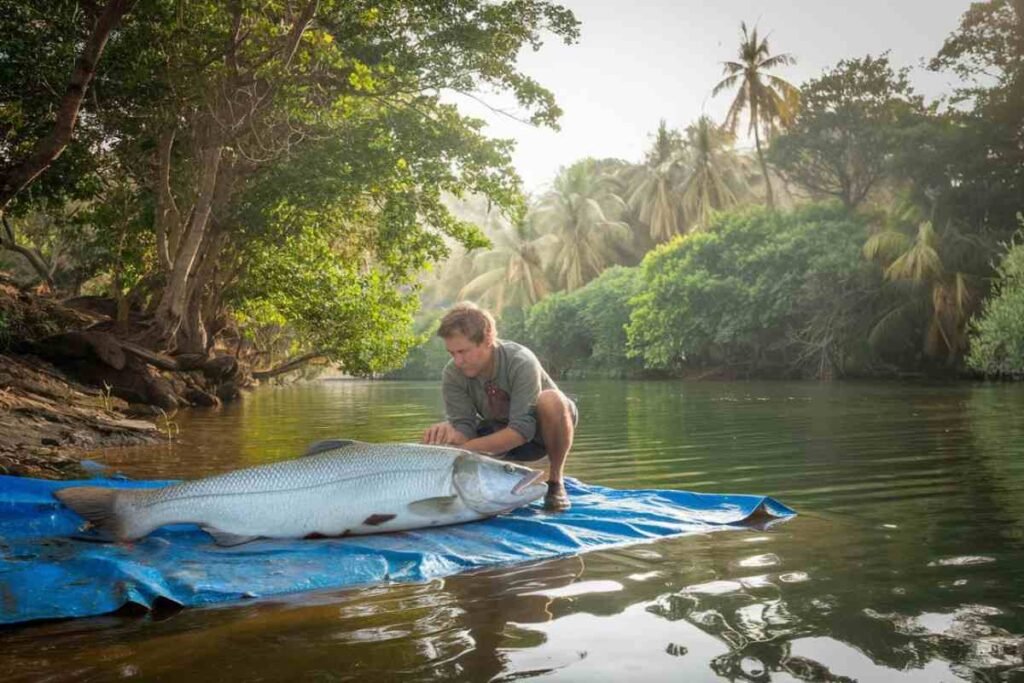The Mekong catfish, scientifically known as Pangasianodon gigas, is a freshwater marvel that thrives in the Mekong River system, spanning countries like Cambodia, Laos, Thailand, and Vietnam. Known for its incredible size and ecological importance, this species has captured the attention of conservationists and nature enthusiasts alike.
Let’s dive into the fascinating world of the Mekong catfish and understand why its preservation is vital.
What is the Mekong Catfish?

The Mekong catfish (Pangasianodon gigas) is a legendary freshwater species native to the Mekong River, flowing through countries like Cambodia, Laos, Thailand, and Vietnam.
Known for its impressive size and ecological significance, this species plays a vital role in the river’s ecosystem. It migrates across vast distances within the river, adapting to various environmental conditions.
Unique Characteristics of the Mekong Catfish
The Mekong catfish is one of the largest freshwater fish in the world. Here are some remarkable traits that make it unique:
- Impressive Size: These fish can grow up to 10 feet in length and weigh over 650 pounds, making them true giants of the river.
- Smooth Appearance: Unlike typical catfish, they lack whisker-like barbels, giving them a sleek and distinctive look.
- Herbivorous Diet: Despite their size, they feed mainly on algae and plant matter, which highlights their gentle nature.
- Migratory Behavior: The Mekong catfish travels long distances within the river, adapting to various environmental conditions for feeding and spawning.
Habitat of the Mekong Catfish

The Mekong River, one of the world’s most biodiverse waterways, provides the ideal habitat for these freshwater giants. This river supports their life cycle in the following ways:
- Spawning Areas: Shallow riverbeds and seasonal floodplains are critical for their reproduction.
- Feeding Zones: Algae-rich areas supply the nutrients they need to thrive.
- Water Quality: The health of the river is crucial, as pollution and habitat degradation directly threaten their survival.
Diet and Role in the Ecosystem
The Mekong catfish plays a crucial role in maintaining the river’s ecological balance:
Biodiversity Support: Their migratory patterns influence other species, supporting a diverse aquatic ecosystem.
Diet: They consume algae and plant material, preventing algae overgrowth that could harm other aquatic life.
Nutrient Cycle: By feeding on organic matter, they contribute to the river’s natural nutrient recycling.
Threats to the Mekong Catfish
Sadly, the Mekong catfish is critically endangered due to human activities and environmental changes. Here are the primary threats they face:
Overfishing
Their massive size makes them a prime target for fisheries. Unregulated fishing has drastically reduced their population.
Habitat Destruction
Infrastructure projects like dams disrupt their migratory routes, while agricultural runoff and deforestation degrade water quality.
Climate Change
Rising temperatures and altered river flow patterns further threaten their delicate habitat and breeding conditions.
Conservation Efforts
Efforts to protect the Mekong catfish are underway, focusing on preserving their habitat and regulating harmful activities:
- Protected Areas: Governments have established conservation zones within the Mekong River to safeguard critical habitats.
- Sustainable Practices: Local communities are being educated on eco-friendly fishing methods to reduce harm.
- Breeding Programs: Conservation organizations are working on breeding and releasing programs to bolster wild populations.
The Importance of the Mekong Catfish

The Mekong fish holds a special place in the lives of river communities:
- Cultural Symbol: In many Mekong-region cultures, this fish symbolizes the river’s vitality and abundance.
- Economic Role: Despite its endangered status, it remains a source of livelihood for some fishermen, underscoring the need for sustainable practices.
Conclusion
The Mekong catfish is not just a fascinating creature but a vital part of the Mekong River ecosystem and local culture. Its survival depends on a collective effort to address overfishing, habitat destruction, and climate change.
By supporting conservation initiatives and raising awareness, we can ensure that this gentle giant continues to thrive and inspire future generations.
FAQs
What is the lifespan of the Mekong catfish?
These fish can live up to 60 years under optimal conditions.
What do Mekong catfish eat?
They are herbivores, feeding primarily on algae and plant matter.
Where are they found?
They are native to the Mekong River, which flows through Southeast Asia.
Why is the Mekong fish endangered?
Overfishing, habitat destruction, and climate change are the primary reasons for their critical status.
Can they be kept in aquariums?
Due to their immense size, they are unsuitable for home aquariums but can sometimes be seen in large public aquariums.
What is their role in the ecosystem?
They help maintain algae levels and contribute to the nutrient cycle, supporting the river’s biodiversity.
How can we help conserve the Mekong fish?
Support sustainable fishing practices, raise awareness about their plight, and contribute to conservation programs.
What temperature range do they prefer?
They thrive in water temperatures between 25°C and 30°C (77°F to 86°F).




